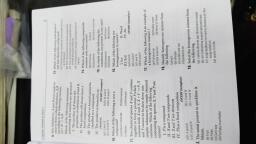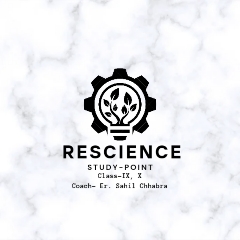Question 1 :
How will you separate a mixture containing kerosene and petrol (difference in their boiling points is more than $25^\circ$C), which are miscible with each other?
Question 2 :
To make a saturated solution 36 g of sodium chloride is dissolved in 100 g of water at 293 K. Find its concentration at this temperature.
Question 4 :
State whether 'melting of butter in a pan' is chemical or physical change.
Question 6 :
State whether 'making a fruit salad with raw fruits' is chemical or physical change.
Question 7 :
Classify whether the following is element, compound or mixture: Carbon dioxide
Question 10 :
State whether 'burning of paper and wood' is chemical or physical change.
Question 11 :
Joseph jogs from one end A to the other end B of a straight 300 m road in 2 minutes 30 seconds and then turns around and jogs 100 m back to point C in another 1 minute. What is Joseph’s average velocity in jogging from A to C?
Question 12 :
<img style='object-fit:contain' src='https://teachmint.storage.googleapis.com/question_assets/cbse_ncert/61b1d2cef59b460d7261f631.png' />
The distance-time graph of three objects A,B and C is shown above,According to this graph,Are all three ever at the same point on the road?
Question 13 :
An object has moved through a distance. Can it have zero displacement?
Question 14 :
Usha swims in a 90 m long pool. She covers 180 m in one minute by swimming from one end to the other and back along the same straight path. What is the average speed of Usha?
Question 15 :
A stone is thrown in a vertically upward direction with a velocity of $5 m s^{-1}$. If the acceleration of the stone during its motion is $ 10 m s^{-2}$ in the downward direction, what will be the height attained by the stone ?
Question 16 :
A car accelerates uniformly from 18 km $h^{–1}$ to 36 km $h^{–1}$ in 5 s. What is the acceleration ?
Question 17 :
A ball is dropped gently from a height of 20m. If its velocity increases uniformly at the rate of 10 $m/s^2$, after what time will it strike the ground?
Question 18 :
Usha swims in a 90 m long pool. She covers 180 m in one minute by swimming from one end to the other and back along the same straight path. What is the average velocity of Usha?
Question 19 :
An object is dropped from rest at a height of 150 m and simultaneously another object is dropped from rest at a height 100 m. What is the difference in their heights after 2 s if both the objects drop with same accelerations?
Question 20 :
<img style='object-fit:contain' src='https://teachmint.storage.googleapis.com/question_assets/cbse_ncert/61b1d29bf59b460d7261f5ec.JPG' />
In the above figure, the velocity-time graph shows the motion of a cyclist. Find its velocity.
Question 21 :
The average velocity of an object is obtained by which of these formulas ?
Question 22 :
<img style='object-fit:contain' src='https://teachmint.storage.googleapis.com/question_assets/cbse_ncert/61b1d2f0f59b460d7261f65f.jpg' />
The speed-time graph for a car is shown in the the above figure. Which part of the graph represents uniform motion of the car?
Question 23 :
A train starting from a railway station and moving with uniform acceleration attains a speed 40 km$h^{–1}$ in 10 minutes. What is its acceleration?
Question 24 :
A ball is dropped gently from a height of 20m. If its velocity increases uniformly at the rate of 10 $m/s^2$, with what velocity will it strike the ground?
Question 25 :
Joseph jogs from one end A to the other end B of a straight 300 m road in 2 minutes 30 seconds and then turns around and jogs 100 m back to point C in another 1 minute. What is Joseph's average speed from A to C?
Question 26 :
A bus starting from rest moves with a uniform acceleration of $ 0.1 m s^{-2}$ for 2 minutes. What is the speed acquired ?
Question 27 :
An object starting from rest travels 20 m in first 2 s and 160 m in next 4 s. What will be the velocity after 7 s from the start?
Question 28 :
The object covers equal distances in equal intervals of time, it is said to be in uniform motion. TRUE or FALSE ?
Question 29 :
What is the nature of the distance-time graphs for uniform motion of an object?
Question 30 :
The brakes applied to a car produce an acceleration of $6 m s^{-2}$ in the opposite direction to the motion. If the car takes 2 s to stop after the application of brakes, What is the distance it travels during this time?
Question 32 :
A batsman hits a cricket ball which then rolls on a level ground. After covering a short distance, the ball comes to rest. The ball slows to a stop because
Question 33 :
An object of mass 1 kg travelling in a straight line with a velocity of 10 m/s collides with, and sticks to, a stationary wooden block of mass 5 kg. Then, they both move off together in the same straight line. What is the velocity of the combined object?
Question 34 :
An object of mass 100 kg is accelerated uniformly from a velocity of 5 m/s to 8 m/s in 6s. What is the initial and final momentum of the object?
Question 35 :
A stone of 1 kg is thrown with a velocity of 20 m/s across the frozen surface of a lake and comes to rest after travelling a distance of 50 m. What is the force of friction between the stone and the ice?
Question 36 :
An object of mass 100 kg is accelerated uniformly from a velocity of 5 m/s to 8 m/s in 6s. What is the magnitude of the force exerted on the object?
Question 37 :
An object of mass 1 kg travelling in a straight line with a velocity of 10 m/s collides with, and sticks to, a stationary wooden block of mass 5 kg. Then, they both move off together in the same straight line. What is the total momentum just before the impact and just after the impact?
Question 38 :
Suppose a ball of mass m is thrown vertically upward with an initial speed v, its speed decreases continuously till it becomes zero. Thereafter, the ball begins to fall downward and attains the speed v again before striking the ground. It implies that the magnitude of initial and final momentums of the ball are same. Yet, it is not an example of conservation of momentum. Why?
Question 39 :
A motorcar of mass 1200 kg is moving along a straight line with a uniform velocity of 90 km/h. lts velocity is slowed down to 18 km/h in 4 s by an unbalanced external force. What is the change in momentum?
Question 40 :
A horse continues to apply a force in order to move a cart with a constant speed because the force applied by the horse balances the force of friction.
Question 41 :
Two objects of masses 100 g and 200 g are moving along the same line and direction with velocities of 2 m/s and 1 m/s, respectively. They collide and after the collision, the first object moves at a velocity of 1.67 m/s. What is the velocity of the second object?
Question 42 :
Two friends on roller-skates are standing 5 m apart facing each other. One of them throws a ball of 2 kg towards the other, what will be the net force of person who catches it?
Question 43 :
<img style='object-fit:contain' src='https://teachmint.storage.googleapis.com/question_assets/cbse_ncert/61b1d2e3f59b460d7261f64e.jpg' />
The above image is the distance-time table of an object in motion. What do you infer about the forces acting on the object?
Question 44 :
Which of the following has more inertia, a five rupes coin or a one rupee coin?
Question 45 :
Using second law of motion, derive the relation between force and acceleration. A bullet of 10 g strikes a sand-bag at a speed of $10^{3}ms^{-1}$ and gets embedded after travelling 5 cm. Calculate the time taken by the bullet to come to rest.
Question 46 :
Using a horizontal force of 200 N, we intend to move a wooden cabinet across a floor at a constant velocity. What is the friction force that will be exerted on the cabinet?
Question 47 :
A 8000 kg engine pulls a train of 5 wagons, each of 2000 kg, along a horizontal track. If the engine exerts a force of 40000 N and the track offers a friction force of 5000 N, then what is the net accelerating force?
Question 49 :
<img style='object-fit:contain' src='https://teachmint.storage.googleapis.com/question_assets/cbse_ncert/61b1d284f59b460d7261f5cc.png' />
Velocity versus time graph of a ball of mass 50 g rolling on a concrete floor is shown in the figure. Calculate the frictional force of the floor on the ball.
Question 50 :
What is the momentum of an object of mass m, moving with a uniform velocity v?








































